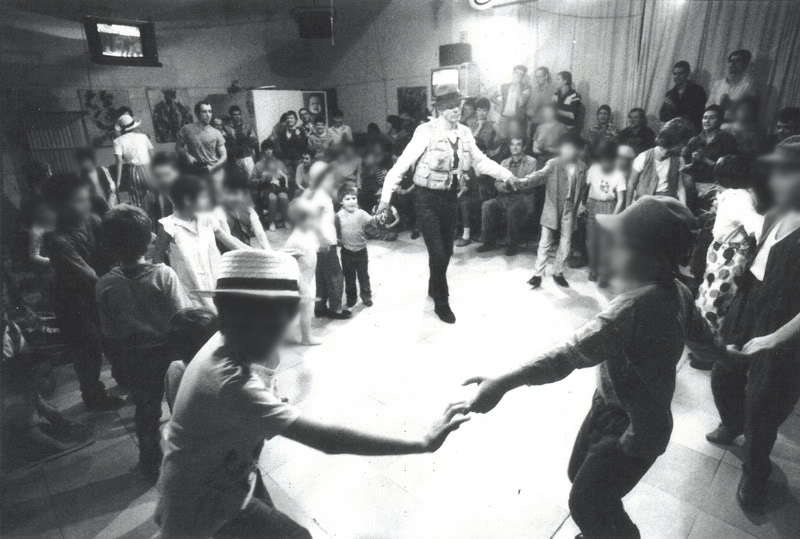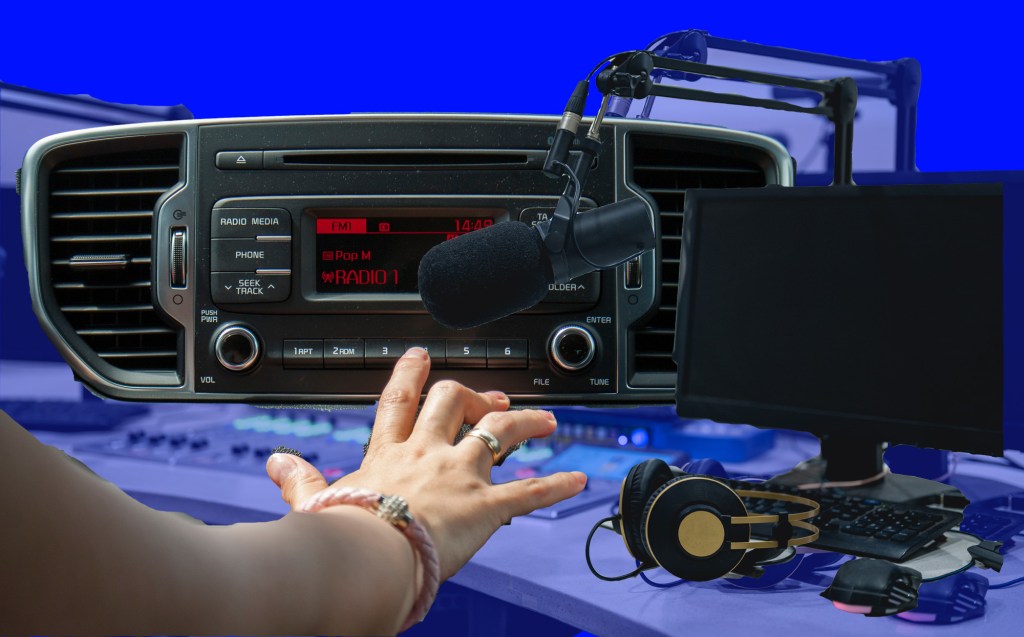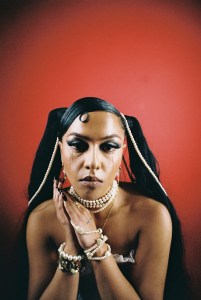The Australian music scene is undernourished and underdeveloped.
That might seem like a big statement to make, but compared to the US and UK markets, the discovery of new music on a national scale has become increasingly difficult. You could point the fingers at any number of things: the rise of streaming; the lack of funding; the pandemic; or even Triple J, the nation’s public youth broadcaster.
Videos by VICE
Though radio has always played an important role in supporting and discovering local artists, the rise of platforms like TikTok and streaming services has meant the way young artists are supported and platformed has changed.
In mainstream channels, international acts are often referenced over local ones and while there are many reasons for this, including staying relevant to mandated audiences, it creates a disparity between international and Australian music.
But increasingly, smaller platforms – like independent radio and publications – have created communities that form new ways to support artists, even acting as funnels of talent to national broadcasters like Triple J.
Artist Kitty Chrystal, from Melbourne’s Nite Fruit, say that they and bandmate Prani Harrison found a supportive community in local stations like PBS, RRR, 3CR, FBi and 4zzz, who often champion their alternative sound and have offered numerous interviews over the years
“In 2021 the Wiggles won the Hottest 100, and the consensus was that people voted as a joke,” Chrystal told VICE.
“Which I don’t blame any individual voters for, but it speaks volumes about how the public at large just aren’t tuned in to the struggles of independent artists, and aren’t aware that their votes, used meaningfully, could make huge changes for emerging artists.”
There’s nothing new about the arguments surrounding national broadcasters, particularly on radio: they’re playing the same music; they’re not highlighting new talent; they’re too mainstream. It’s especially the case in genre – Triple J and its “Triple J sound” (of a sort of indie surf, slightly pop persuasion) is usually the main target.
A self-described champion of alternative Australian music, Triple J has been facing a years-long uphill battle with a youth audience that has been gradually dwindling. The Hottest 100 has become an internationalised list of talent: in 2021, six songs in the top 10 were from acclaimed international acts, including Doja Cat, Lil Nas x, Justin Bieber, Olivia Rodrigo, Billie Eillish and Jack Harlow. The Wiggles Like A Version, a cover, took the number 1 spot.
That might not be the only reason Triple J’s listenership has decreased, especially in the 18-to-24 year old category (which they are mandated to reach) but it is the most obvious.
“I just feel like, in chasing an audience, national broadcasters and commercial media have narrowed their focus significantly, because now they’re fighting with streaming services,” Simon Miraudo, General Manager at Perth’s RTRFM, told VICE.
RTRFM is one of Perth’s leading independent radio stations and relies on listener support and fundraising for funding. Much of the music featured on their website and station comes from artists with small listening bases who are local to Western Australia.
“The role of discovery and nurturing has fallen to community media and community radio,” said Miraudo.
“There’s no problem with pop music or mainstream music, but I think by focusing on what they think young people want to listen to… the vital space is now missing to discover great acts coming out of Australia.”
According to Miraudo, the increasing shift of national stations away from alternative music has pushed local acts and artists to the fringes – a place populated by musicians who had once seen stations like Triple J as an ideal access point for airtime and a national audience.
Cities like Perth, consistently snubbed in the music community because of its distance from cities that are seen as the “main hubs”, have created their own vital ecosystems to support local artists and their community. At present, stations like RTRFM organise dozens of live music events a year, including fundraisers for under-served communities.
“One of the biggest problems in Australian arts (not just music) is regionalism. If you’re not based in Melbourne or Sydney, you’re rooted. Sadly, the some of the best music is coming from WA, SA, and Tasmania, and has been for a while,” Fremantle artist and writer Bang Bang Bart told VICE.
“I think, for me, the best support has and always will come from community radio. RTRfm is run by saints who do everything to champion music – and a scene – that otherwise has to fight tooth and nail just to get a 200 word blurb in the national music press (or what remains of it).”
But Triple J’s digital presence, Unearthed, still deserves credit for its recognition of up and coming talent. The platform has been responsible for the rise of Ball Park Music, Tkay Maidza and Courtney Barnett, and is an important foundation allowing young artists to at least feel like they have a shot. But its parent brand has begun to lack the grassroots nature that many artists rely on, especially throughout the early stages of their careers.
“Engaging with the community in a more personal way through in-person gigs, genuine friendships and collaborations formed through Instagram, and the connections we’ve made through community radio, helps us prioritise making music from an authentic place…Rather than sacrificing our creative integrity to make something more palatable in a commercial sense,” said Nite Fruit’s Kitty Chrystal.
It’s this willingness to play new talent, without change, that concretes the importance of independent radio and publications outside of the government-funded sphere.
One station that has consistently held influence is Sydney’s FBi Radio. While Reg Harris, the station’s musical director, recognises the homogeneity of national broadcasters, he says that playing unheard and upcoming music can be attributed to not feeling pressured to cater to the rigid parameters of commercial radio.
“Our purpose isn’t to sell ad space and fixate on ratings,” he told VICE.
“We can focus on acting as an amplifier for communities. Not only does independent radio play a significant role in breaking artists but has a unique place in developing ongoing and more personal relationships with artists that nurture them throughout their career.”
It’s the structure itself of independent radio stations, where they have the ability to focus on hyper-local events, that differentiates them from national broadcasters who have to cater to the whole country. Though their audience is smaller, it allows their content to be more hyper-focused on what’s happening. In doing so, they’re able to accurately reflect the niche movements of trends occurring around them. For instance, Matthew Perrett, music director at RTRFM, cites being sent hundreds emails from local artists a week, each filled with new music. For national broadcasters, that’s multiplied tenfold.
“It has to be consumed quickly – and then consumers are also looking for that same immediacy that artists and broadcasters are. So the grittiness and humanness is taken out of it, because everything needs to be done quickly to compete with other forms of consuming media,” he told VICE.
“It’s easy for RTRFM to focus on local artists and give them a voice, because legally [all community stations in Australia] have to play 25% local music. The idea of having to expand that to the entire country boggles my mind.”
These days, independent radio stations act as the funnel for national broadcasters to find new music, artists, and even on-air talent.
“These independent pages are a godsend, and often do far more work than the big businesses do in researching, promoting, creating content and even hosting events for our artists,” Melbourne artist and producer Martian told VICE.
“They should receive far more support, ESPECIALLY from Triple J and labels, since they’re basically doing their job for them.”
Martian, who has been releasing music since 2015, says the role of artists these days has become multidisciplinary. Most have to make music, be their own social media coordinators, have top tier visuals, post daily content and pull together their own budget.
“If you take a break for your mental health or work or family reasons… you quickly disappear into irrelevance. It’s tough. For young artists there is no single place to learn this industry or the immense amount of skills needed to grow” he said.
“All the ports for mass exposure are closed and only open if you fit the current wave/demographic that they’re desperately trying to capitalise on, simultaneously ignoring the 99% remainder of incredible artists left unheard.”
“Unfortunately the vast majority of Australian radio is the last to onboard and would rather opt for playing global megastars on repeat.”
When it comes to stations like Triple J, Martian says that they’ve spent too much time “beating their own chest” and not enough time “curating, supporting and putting on dope artists – which is what made them a great station in the first place.”
“More artists need to come to the table and discuss how to support culture and how we as artists and music lovers can make this space easier to access,” he said.
In regards to funding, many local stations that rely on volunteers, have suffered heavily under the previous Coalition government’s arts funding cuts. While the new government reversed those cuts for stations like the ABC – who are set to receive an additional $83.7 million over the next four years – no new arts initiatives were introduced anywhere else.
“It can make it sort of challenging on a financial level, and so very much community radio relies upon the financial support of its listeners through subscriber drives, sponsorship from local businesses, and organisations and musicians,” Simon Winkler, a music coordinator from Melbourne’s Triple R, told VICE.
Similarly, in Perth, Perrett says that they lack a strong peak music body. Though they have West Australian Music (WAM), the organisation is facing a dwindling in funds and has recently undergone restructuring.
“They’re running on, like, two or three staff members. RTRfm, not that we’re necessarily at peak body level, but we kind of act as one from a broadcaster and community outreach perspective. We also have just been knocked back for funding from a couple of the government bodies,” said Perrett.
“So there’s the national awards that shine a massive light on folks, but that people power and the money to pay people to be able to do that just isn’t here. And there are folks genuinely struggling to pursue a creative career.”
According to Bang Bang Bart the only way to truly fix these problems, apart from editorial boldness from media outlets and a practically impossible shift in the public’s taste is “a royal fuck tonne of government cash into the arts.”
“I just can’t see that happening. The tragedy of Triple J constantly playing music that could also be used in bank ads is that the merger of the corporate and artistic sphere in Australian music has left us with a kinda unbreakable jerk circle – of publicity agents and middlebrow journos – that can’t really be broken unless something truly radical happens”, he said.
Parry Tritsiniotis from Purple Sneakers, a Sydney-based music and culture publication, says that if commercial radio was held to account for their lack of support for Australian musicians it would make every other aspect of Australian music stronger. Music on a national scale would reflect the movements of the communities more accurately. Tritsiniotis says many broadcasters even struggle to hit the mandated amount of Australian programming.
“Because the government isn’t doing anything to enforce national broadcasters to play Australian music,” he told VICE.
“I think they’re meant to play like 40 or 50% Australian music and they most likely aren’t at the moment. The bureaucracy is interesting.”
While listenership on radio stations might be on the decrease as Spotify continues its climb towards a trillion dollar behemoth, independent radio has become the forefront for Australian culture and music. Often, artists struggling to maintain their own presence in the music landscape get their first plays and support from these outlets. It’s something that national broadcasters are increasingly failing to do.
According to Tritsiniotis, the future of Australian music, and culture, sits at the hands of creatives in every city on a grassroots level. Rather than focusing on national broadcasters, it’s up to individuals starting their own blogs, throwing their own parties and taking alternative routes to get Australian music on the map.
“There are potential gatekeepers in any organisation that are going to restrict the progression of some artists,” Tritsiniotis said.
“I just hope that that doesn’t discourage people from doing their own thing and starting their own organisations, their own blogs, their own companies or online radio stations. I think that’s the main thing: we need to make sure that, from an independent point of view, we are unafraid to tap into a similar market and reflect a different point of view.”
Follow Julie Fenwick on Twitter and Instagram.
Read more from VICE Australia and subscribe to our weekly newsletter, This Week Online.
More
From VICE
-

Geoffrey Clowes -

Collage by Vice -

Photo by Angga Budhiyanto/ZUMA Press Wire/Shutterstock -

Children at the Friedrichshof Commune dance with renowned artist Joseph Beuys. Inka, aged four, holds his right hand.







